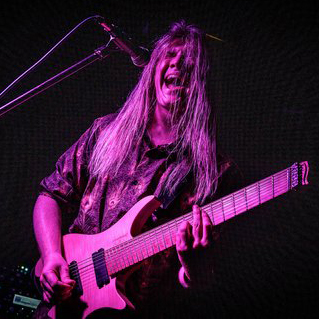“I’ve gotten comments like ‘a guitar’s not supposed to do that’, but where’s the rulebook? Just because something is wild doesn’t mean people shouldn’t enjoy it”: Syncatto’s Charlie Robbins is pushing the boundaries of technique beyond belief
From crafting presets for Neural DSP to convincing the internet that his warp-speed selective picking riffs aren’t fake, the Syncatto mastermind is a technical and tonal trendsetter. He reveals how drum rudiments shaped his playing, and the secret to his trademark biting clean tone

While Charlie Robbins, the brains and fingers behind genre-bending instrumental project Syncatto isn’t alone in his adoption of modern guitar techniques, he’s one of a few translating them into his own language. Even if sometimes that’s by accident.
“It’s funny because a lot of the techniques I've learned over the years I thought I was doing wrong. Then I’d write a riff with it anyway,” Robbins says. “When I write thumping and selective picking riffs, I like to move across a lot of different strings because it’s much easier to outline chords, arpeggios and progressions.
“When you have a clear progression it’s easier for the listener to follow along. It’s like you have the outlines of a coloring book; it’s then up to you how you colour the spaces to make it your own.
“A huge aspect of the excitement of music is when it's not predictable,” he explains. “If you like a certain guitarist or sound, that's a route you should take your playing down. But there are aspects of music that I think should be left up to chance and experimenting. Sometimes it may sound weird or off the wall, but other times you’ll have something fresh and different that’s in your own voice.
“For instance, I was selective picking across different strings using drum rudiments that bounce between your hands, almost as a little ASMR thing to fill the space in a riff. People end up liking it, which felt like the golden ticket.”
The 30-year-old grew up in the metalcore era, with songs like Avenged Sevenfold’s Sidewinder turning him onto classical and flamenco guitar playing and diversifying his palette.
“Bands like The Human Abstract had the biggest influence on me and Gerudo Valley was my favourite song on the Zelda games,” Robbins enthuses. “So when I started piecing it all together, I decided to study classical guitar at college and start from scratch.”
Get The Pick Newsletter
All the latest guitar news, interviews, lessons, reviews, deals and more, direct to your inbox!
Despite his foray into classical playing, he’s remained a drop C loyalist, which has helped him stand out from his prog-playing peers. His tuning may be unchanged, but his desire to bring new sounds and ideas into his playing burns more fiercely than ever.
“Guitarists like Tosin Abasi have been super-important in creating this space where you can do crazy things with your instrument,” he beams. “I think, as guitar players, we can feel very connected to our styles, and I’ve gotten comments like ‘a guitar’s not supposed to do that’, but where’s the rulebook? Just because something is wild doesn’t mean people shouldn’t enjoy it.”
Whilst admitting that selective picking “does look insane as it goes against your intuition as a guitarist”, it’s proved too much for some people online who were convinced that a riff on his song Flow was so insane that it couldn’t possibly be real.
“It was surprising,” he reflects. “Even after I recorded a video explaining the riff – twice – people still thought it was fake.”
The technique involves open G string muting in groups of three with your right hand, while your left hand taps through arpeggiated shapes across multiple strings, which are also muted to give a percussive sound. It shines on in his latest single, Nightfall too, with the idea incorporated into a breakdown-style groove, extending further into the ‘color the spaces’ approach that defines much of his riff writing.
Players familiar with Neural DSP’s Archetype plugins will recognise Robbins’ name, with the guitarist having contributed tone presets since their early days. Tone, he says, is a key distinguisher of the Syncatto sound.
“It's almost maddening how much of a rabbit hole tone is, but the guys at Neural have made it so much easier. Being able to make tones for people who don’t know how to makes tones is a great feeling. I remember how lost I was when I first got my Axe-Fx and I had this crazy technology but I had no idea how to use it. It forced me to learn about things like EQ, which made me better at mixing my own music, too.”
That’s led him to perfecting the craft of sculpting clean tones that offer bite and clarity in equal measure.
“You have to create the illusion of it being distorted without distorting,” he believes. “The two ways I've learned to do it is that you can either push up or pull down depending on the amp you're using. With British amps that aren't as pushed as, say a 5150, you can bring it down and then compress what you've brought down and that almost works instantly, without much EQ.
“The other way is to take a clean tone and use an OD pedal with a touch of gain, which will give you that fuzz without losing the clarity. Then you go to the EQ and the hot points are 2,500Hz for punch and then 4k and 8k to add brightness to it, and from there you can scoop out the mids to get a single coil sound that's really percussive.”
Robbins jumps between two main guitars: his newly released signature Kiesel Artist Series Aries in Seafoam Green – “I’m an aesthetics guy, so not much has changed in terms of specs, but it’s got lighter woods and a really classy look” – and the Cordoba Stage electric nylon, of which he was one of the first champions.
Says Robbins: “Generally, I don't like electric nylons because they don't have the particular sound that I go for, but this was a nice little hybrid between both worlds. I can just plug it in and start playing into my DAW, and you can also blend in the Fishman pickup which creates a more authentic sound. That just changed it for me. It's a step in the right direction of where I think nylons should go.”
With a Syncatto album and an Artificial Language EP both at the mixing and mastering stages of production, 2024 is set to be a whirlwind year for the guitarist – if only he can convince the internet misers of his authenticity…
A freelance writer with a penchant for music that gets weird, Phil is a regular contributor to Prog, Guitar World, and Total Guitar magazines and is especially keen on shining a light on unknown artists. Outside of the journalism realm, you can find him writing angular riffs in progressive metal band, Prognosis, in which he slings an 8-string Strandberg Boden Original, churning that low string through a variety of tunings. He's also a published author and is currently penning his debut novel which chucks fantasy, mythology and humanity into a great big melting pot.
“There’d been three-minute solos, which were just ridiculous – and knackering to play live!” Stoner-doom merchants Sergeant Thunderhoof may have toned down the self-indulgence, but their 10-minute epics still get medieval on your eardrums
“There’s a slight latency in there. You can’t be super-accurate”: Yngwie Malmsteen names the guitar picks that don’t work for shred


![A black-and-white action shot of Sergeant Thunderhoof perform live: [from left] Mark Sayer, Dan Flitcroft, Jim Camp and Josh Gallop](https://cdn.mos.cms.futurecdn.net/am3UhJbsxAE239XRRZ8zC8.jpg)







